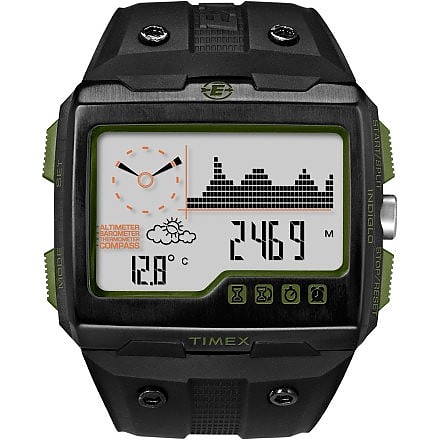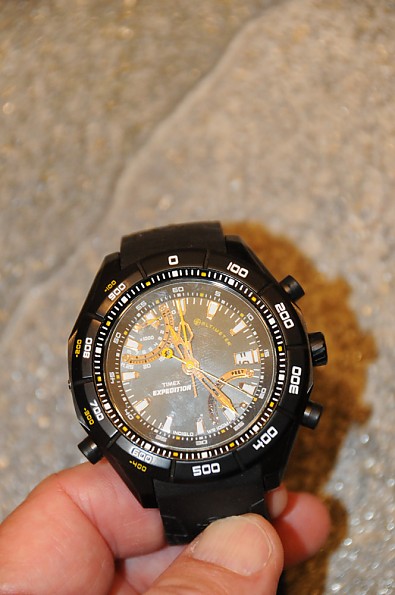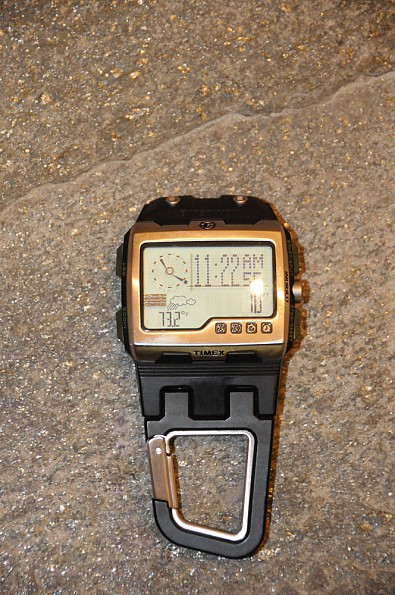Timex Expedition WS4

Timex provided me with two of their outdoor watches at the Outdoor Retailer Show for review. They are the Expedition WS-4 and the Expedition e-Altimeter (W257).

The e-Altimeter is one of several "analog" watches with special instrumentation for various aspects of outdoor use. The series is really a "street" watch, more for showing your "lifestyle" than for real use in the outdoors. The watch itself is rather large and heavy on the wrist, although you get used to it after a while.
While the altitude functions are somewhat useful, they are very limited. You can display the altitude in feet or meters (choice shown on the half-circle in the lower right of the face) as current altitude, maximum altitude since reset and minimum altitude since reset. Since the sensor is a barometric sensor, the altitude shown is dependent on the air pressure, which changes at a given location according to the weather. Re-calibration is easy enough. However, the main dial shows steps of 10 feet for each thousand feet, with the small semicircle at the left of the 12 o'clock position showing the thousands of feet or meters, to a maximum of 25,000 ft or 8000 meters. The hands (hour, minute second, 10s of feet or meters) are luminous and can be seen for a while in the dark.
The big problem I found is that the numbers for altitude are so tiny that a magnifying glass is almost a requirement. I would give this watch and the rest of the series 4.5 stars for appearance and 2 stars for real usefulness in the outdoors. You certainly would not want to go rock climbing with it, especially jam cracks.
The "Wide Screen" WS-4 series is a different story. The watch was designed with advice from the famed climber, Conrad Anker (many items for the outdoors, from clothing to technical gear are designed in consultation with "sponsored climbers", in this case to great benefit). The display is mostly digital, with a small "analog" dial to show time at the upper left of the wide screen display and a "weather forecast" cartoon in the lower left, along with the air temperature. The analog dial is actually digital, with the minute hand jumping rather than continuously moving. The forecast cartoon can be calibrated (it was actually raining outside when I took the image below).
The WS-4 comes in several styles to be worn on the wrist, or with a “carabiner clip” to hang from your belt, pack strap, or anywhere else you have a place to clip it. The carabiner version was the one supplied for test. Having had numerous wrist-mounted watches, I found the carabiner clip to be far more useful for outdoor activities like climbing or skiing. Like many Timex watches, a night light, called “Indiglo” by Timex, is provided via the center button on the right side.
 On the "home" screen, as shown, the time of day and altitude are on the right side. The altitude can be switched among absolute barometric pressure, day of the week and date, and altitude. The time of day can be switched to a second time zone (I keep mine on Universal Time, aka Greenwich Mean Time).
On the "home" screen, as shown, the time of day and altitude are on the right side. The altitude can be switched among absolute barometric pressure, day of the week and date, and altitude. The time of day can be switched to a second time zone (I keep mine on Universal Time, aka Greenwich Mean Time).
The next screen is the altitude screen. on first switching to the screen, it shows peak altitude and net gain/loss since reset, then settles on current altitude. The upper right can be switched to display a graphic altitude vs time chart or the current altitude. The units of the graphical displays are not displayed nor described in the information sheet that comes with the watch.
I eventually deduced that the horizontal scale is one hour per step (36 hours total visible at a time), and an inquiry to Timex gave the information (not in the information with the watch) that the vertical scale is about 3000 ft per step, with the current altitude in the middle. In the Chronometer mode (discussed below), the time step is one minute. Thus all the graphical displays are relative scales only.
The third screen is the barometric pressure, again showing highest and lowest absolute pressure since reset, then settles on current absolute pressure or a graph, with the current sea level pressure in the lower right. I thought it a bit peculiar that the pressure display was chosen to be absolute pressure (QFE, for the technical types), rather than the sea level equivalent reduced pressure (QNH, the value given by the weather reports on TV, NOAA Weather Radio, and airport control towers). On asking Timex about this, their explanation was:
Currently, the pressure is displayed as min/max/avg is absolute. We believe this is easier for the user to understand, as sometimes presenting more information (i.e. QNH) could lead to confusion.
As an airplane pilot, I can deal with either one. But I believe that the absolute pressure is likely to be less clear to the majority of users than the sea level pressure. Since the altimeter (which is also barometric pressure based) has to be calibrated frequently at known altitude points or from the reported sea level pressure in any case (via the Calibration window), it would seem more logical to use sea level pressure for the default display. Absolute pressure is very useful to the high altitude mountaineer or polar explorer. For the sailor on the ocean, absolute pressure and sea level pressure are the same (the ocean surface is by definition sea level, with some minor complications we won’t discuss here). As I experienced in Antarctica, the actual atmospheric pressure on the polar plateau and on the slopes of the Vinson Massif is significantly lower than expected for the geometric altitude (at the 16,000 foot elevation at Vinson’s summit, the air pressure is equivalent to that on Kilimanjaro’s summit 3 degrees south of the equator, about 19,000 feet).
The fourth window is the magnetic compass display. I was pleased that the compass needed only infrequent recalibration, although one would want to reset the magnetic declination when moving long distances. The analog clock display changes to an analog compass display with a digital reading in the lower left in place of the temperature.
The fifth window is the Chronometer, or stop watch. If you clear the stored data from the Review window (sixth window), running the chronometer will store altitude maxim and minimum, total ascent and descent, the time above a selected altitude, a graphical display of the altitude with time (one minute per time step), highest, lowest, and average barometric pressure (again, absolute pressure), graphical display of the pressure with time, highest, lowest, and average temperature and a graph of temperature vs time. Although you can take intervals and lap time, there is no way of reviewing more than the current leg. That is, unless you write down lap and split time immediately on marking it, you cannot later go back to review your progress. Again, I consider this a significant deficiency.
The sixth window allows reviewing the data stored during the running of the chronometer.
Window 7 is a count-down timer, while window 8 allows setting a single alarm. The alarm can be set for daily, weekdays only, weekends only, or any single day of the week.
The ninth and final window is for calibration. The choices are for pre-setting the altitude of home base plus 3 other bases or a “manual” base, barometer calibration, and the “weather forecast” according to the current weather.
Overall, I found the WS-4 to be very useful, which is why I give it 4 stars. There are a number of places where it could be improved, such as being able to review the stopwatch intervals, as you can do with Polar and Suunto wrist-top “computers”. Unlike the Polar and Suunto models, there is no way to download the information to a computer, and no way to review the lap and split times. The graphical displays are only qualitative, unlike the information available with Polar and Suunto models. Of course, you can normally review all the data that the Polar and Suunto models provide only after returning home and downloading, not at high camp on Mount Superchallenge.
Source: received for testing via the Trailspace Review Corps
Price Paid: sample provided for review
A nice watch that is quite large on the wrist. Does quite well for casual use, but the functions such as altimeter, compass and thermometer are very inaccurate.
Pros
- Looks nice
- Intuitive to use
Cons
- Altimeter is worthless
- Compass is worthless
- Thermometer is worthless
- Massive size
I got this watch in late 2011 because it was the cheapest altimeter I could find... bad idea. It works great as a casual watch, other than being quite large. I think it looks quite nice, and recieved compliments about it, though more often people ask what in all the contraption on my wrist does! The functions are intuitive and easy to use compared to my Casio watchs, and the watch includes a quick guide to calibrating and setup that makes things very easy. The massive face makes reading easy.
From wearing this daily since 2011, I have found that as tool for climbing this is a horrible watch. The altimeter, even when I calibrate it at the trailhead, is 200 meters off in a couple hours compared to my GPS. Even hanging around my house if I reset it in the morning I'll gain a hundred meters by lunchtime while watching TV! This is because of air pressure changes, but still suprises me given that my friends Polars and Suuntos don't do the same thing.
The thermometer is useless. It is consistently about half way between my body temp and air temp, +/- 5 degrees.
The compass is the same story. I set it and go on a bike ride and it might be 45 degrees off after a couple rides. The compass is displayed in the analog watch face and is not easy to read as a result.
The other problem is that the watch is so huge that I cannot wear gloves easily with it on, and it occasionally restricts movement of my wrist.
A nice watch, but a bad tool for the mountains.
Source: bought it new
Price Paid: $100



